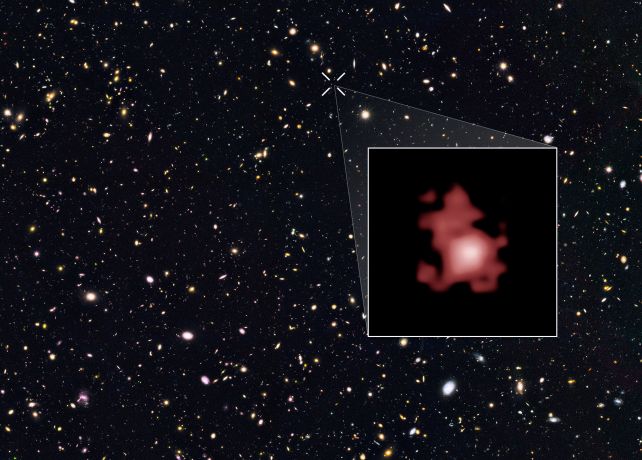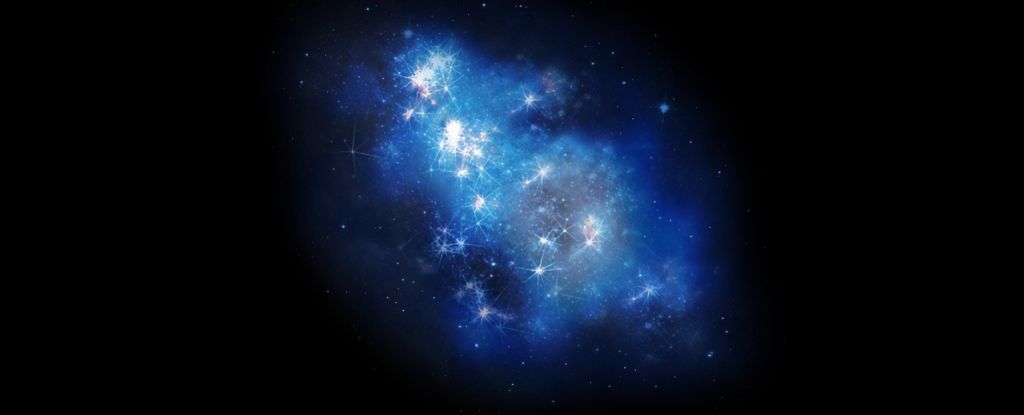A glimmer flickering from across the gulf of time and space is the earliest black hole we’ve ever seen.
The light detected by a team led by astrophysicist Roberto Maiolino of the University of Cambridge is the blaze emitted by the black hole’s host galaxy as it swirls inexorably towards the event horizon. Appearing as it was just 400 million years after the Big Bang, the black hole is already massive – some 1.6 million times the mass of the Sun.
It’s a discovery that seems to confirm the direct collapse model of supermassive black hole formation in the early Universe, rather than the long, slow process of accretion from something the mass of a large star.
“It’s very early in the Universe to see a black hole this massive, so we’ve got to consider other ways they might form,” Maiolino says.
“Very early galaxies were extremely gas-rich, so they would have been like a buffet for black holes.”
The galaxy in question is one we’ve seen before. It’s named GN-z11, and it was identified several years ago from Hubble observations as the earliest galaxy we have seen in the Universe – its light has traveled for 13.4 billion years to reach us (the Big Bang was around 13.8 billion years ago). That record has since been broken by observations from the James Webb Space Telescope (JWST), but GN-z11 is far from done.
JWST launched after the discovery of GN-z11, offering an unprecedented level of sensitivity with which to view the distant Universe. So Maiolino and his team used the new space telescope to get a much more detailed look at GN-z11 than Hubble could provide to see what might be lurking at the heart of the distant galaxy.
The JWST observations captured a spectrum from the galaxy that the researchers teased apart in a detailed analysis to see how the light from GN-z11 was produced. And in the spectrum, they found the signatures of accretion – the process whereby black holes devour matter.
Black holes notoriously don’t produce light themselves. At a certain proximity to the black hole’s center known as the event horizon, gravity becomes so strong that light isn’t fast enough to escape its pull. But outside the event horizon, matter swirls and roils in the extreme environment around the black hole, forming a disk that feeds into it.
That accretion disk absolutely blazes with light, heated by gravity and friction to dominate the light of its host galaxy. That, the researchers found, is the source of light illuminating GN-z11.
In fact, the black hole is feeding at such a fast rate that it is likely to snuff out the baby galaxy: as it feeds, a black hole starts to emanate powerful nuclear winds that will eventually blow away all the star-forming gas in the galaxy, resulting in a quiescent object peacefully drifting through space, forming very few new stars.
GN-z11 is a very small galaxy, researchers believe, around 100 times smaller than the Milky Way. At the rate its black hole appears to be feeding, it would not take long for the gas to be swept away into intergalactic space. In the process, this would cut off the growth of the black hole as it blows away any material it could use for “food”.

The size of the black hole is too massive to have formed from something the size of a star in the 400 million years since the Big Bang; but it can join the club in that respect. Astronomers think that in the early Universe, black holes could have formed directly from the gravitational collapse of huge clumps of matter.
Also, as galaxies all seem to have a black hole at their center, it’s reasonable to think that any earlier galaxies spotted with JWST will also have them.
But GN-z11 is the earliest yet confirmed, and measured, at the dawn of the Universe, during a time known as the Epoch of Reionization. Before this era, space was opaque; it was only as the matter became reionized that space became transparent, and light could flow freely.
One of the burning questions of cosmology is the source of the ionizing radiation. GN-z11 suggests that black holes had a part to play.
“GN-z11 is the first of such hyperluminous galaxies [in the early Universe] to be spectroscopically confirmed, and for which such a detailed spectroscopic analysis has been feasible,” the researchers write in their paper.
“The active galactic nucleus scenario revealed by our analysis provides a natural explanation for the exceptional luminosity of GN-z11. If this is representative of the broader class of luminous galaxies discovered [in the early Universe] by JWST, then it would greatly alleviate the tension with models and simulations, and may suggest a stronger role of active galactic nuclei in the reionization of the Universe.”
The research has been published in Nature.





